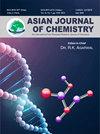Biogenic ZnO Nanoparticles Derived from Garcinia gummi-gutta Leaves: Synthesis, Characterization and its Multifaceted Applications
Q4 Chemistry
引用次数: 0
Abstract
The current study focused on the bioreduction synthesis of ZnO nanoparticles using Garcinia gummi-gutta leaf extracts. The UV-vis analysis of the nanoparticles has reported the formation of an SPR peak at 379 nm. The functional groups taking part in the reduction reaction were analyzed using the FTIR technique and the average crystalline size of ZnO nanoparticles were found to be 22.27 nm from XRD measurements. The SEM and TEM images revealed the hexagonal shape of the nanoparticles with an average size 72.78 nm and 71.91 nm, respectively. Further, the synthesized nanoparticles were reported to be efficient degradation reactive textile dyes. The photodegradation results reported 92-100% degradation of the reactive dyes within 80-320 min. The antibacterial efficacy of the nanoparticles was investigated and the MIC of the nanoparticles was found to be 100 µg/mL. The synthesized ZnO nanoparticles have exhibited significant cytotoxic effects on the MCF and HEP-G2 cell lines.从藤黄树叶中提取的生物纳米氧化锌:合成、表征及其多方面应用
本研究的重点是利用古柯叶提取物生物还原合成氧化锌纳米粒子。纳米粒子的紫外可见光分析表明,在 379 纳米处形成了 SPR 峰。利用傅立叶变换红外技术分析了参与还原反应的官能团,并通过 XRD 测量发现氧化锌纳米粒子的平均结晶尺寸为 22.27 nm。扫描电子显微镜(SEM)和透射电子显微镜(TEM)图像显示,纳米颗粒呈六边形,平均尺寸分别为 72.78 nm 和 71.91 nm。此外,据报道,合成的纳米粒子能有效降解活性纺织染料。光降解结果表明,在 80-320 分钟内,活性染料的降解率为 92%-100%。对纳米粒子的抗菌效果进行了研究,发现纳米粒子的 MIC 值为 100 µg/mL。合成的氧化锌纳米粒子对 MCF 和 HEP-G2 细胞系具有显著的细胞毒性作用。
本文章由计算机程序翻译,如有差异,请以英文原文为准。
求助全文
约1分钟内获得全文
求助全文
来源期刊

Asian Journal of Chemistry
化学-化学综合
CiteScore
0.80
自引率
0.00%
发文量
229
审稿时长
4 months
期刊介绍:
Information not localized
 求助内容:
求助内容: 应助结果提醒方式:
应助结果提醒方式:


